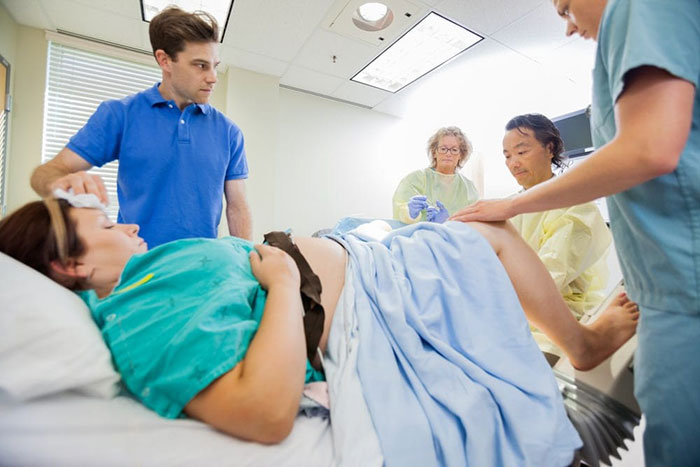Precipitous Labor Leading to Birth Injuries
The childbirth process can be strenuous and painful for an expectant mother, often taking anywhere between 8 to 24 hours from the time her water breaks. But while a precipitous labor (rapid labor) may sound ideal in theory, it increases the likelihood of a delivery complication that will hurt either the mother or her child.

Free Legal Consultation
Birth Complication Lawyers
1-888-987-0005Our Birth Injury Lawyers are available to meet you in your home or the hospital.
Doctors, nurses and other healthcare professionals owe it to mothers who are in precipitous labor to ensure that she and her child are uninjured. If they fail to identify or fail to treat any birth complications that are a result of the mother’s rapid labor, it may constitute medical malpractice.
A newborn can suffer from devastating birth injuries without proper treatment during and after a rapid labor. Some of these potential injuries have lifelong consequences, such as fetal bradycardia, hypoxic ischemic encephalopathy (HIE) or even cerebral palsy.
Miller Weisbrod Olesky has a decades-long track record of results for children and families across the United States that suffer from improperly treated labor and delivery complications. Let us put our experience and expertise to work for you and your child to ensure they receive the treatment, care, and financial resources they deserve. You will not be charged any fees until we win your case.
What Is Precipitous Labor?
A mother is considered to have a precipitous labor (also called rapid labor) when she delivers her child in three hours or less after first experiencing contractions. For reference, a typical labor lasts around 12-24 hours for a mother’s first birth, and is usually shorter (around 8-10 hours, on average) for subsequent pregnancies. Precipitous labor is rare, estimated to occur in about 1-3% of all births.

What is the The Standard Timeline of Labor?
Labor is divided into three stages:
- Stage 1 (Early & Active Labor): Labor typically begins with the mother's water breaking as her uterus begins having consistent muscle contractions. She will likely feel pain in her lower back as well. Her cervix begins to efface (become thinner) and dilate (open).
- Stage 2 (Delivery): During this stage, the mother’s cervix will become fully dilated. She will start to feel the urge to push. It can take anywhere from a few minutes to a few hours for the baby to push through the birth canal.
- Stage 3 (Afterbirth): The final stage of birth involves delivering the placenta after the baby has been born. The placenta is a temporary organ formed in the uterus during pregnancy that delivers oxygen and nutrients to the fetus. It typically takes up to 30 minutes to deliver. The mother’s uterus can then contract to regular size after the placenta passes through.

What Are the Signs of Precipitous Labor?
Rapid Labor can happen unexpectedly and may come with several signs. Some common signs of precipitous labor include:
- 1. Intense Contractions: Labor contractions should gradually intensify as the mother progresses through the early and active stages of labor. During a precipitous labor, however, the mother’s first contractions will immediately feel intensely painful. Since all labor contractions are painful, it may be difficult for a mother to discern whether her first contractions are abnormally intense. If this is the case, doctors and labor and delivery nurse should pay close attention to the time in between her contractions.
- 2. Very Little Time Between Contractions: During the first stage of labor, a mother should expect to experience contractions that are 5-15 minutes apart. This medical condition is known as uterine hyperstimulation. An expectant mother is advised to go to the hospital once contractions are occurring every 5 minutes over the course of an hour. With rapid labor, contractions begin suddenly with very little time in between. The pain may even feel like one continuous contraction with no gaps in between.
- 3. Feeling an Urge to Push: In cases of precipitous labor, a mother will feel pressure in the pelvic area during and shortly after contractions. This is a sign that birth is imminent. Some women who have experienced rapid labor have likened the feeling to that of a bowel movement.
What Causes Precipitous Labor?
In some cases, a mother may experience rapid labor without a definite cause. However, there is a set of risk factors that increase an expecting mother’s likelihood of rapid labor.
What Are Risk Factors for Precipitous Labor?
Precipitous labor can present serious risks for both the mother and baby. Several factors increase the likelihood of experiencing precipitous labor:
- Having a previous case of rapid labor.
- Having previously given birth one or more times.
- A fetus being smaller than average in size, possibly due to fetal growth restriction or intrauterine growth restriction (IUGR).
- Having preeclampsia or high blood pressure.
- Experiencing a placental abruption or uterine rupture in the past or during pregnancy.
- Having a wider-than-average birth canal or wide pelvic bone structure (gynecoid pelvis).
How Can Precipitous Labor Cause Harm?
A precipitous labor can cause harm to both the mother and her child in several ways:
Internal Tearing or Rupturing
The contractions a mother undergoes during precipitous labor can be so forceful that they damage the uterine lining. If this happens, it can cause severe internal bleeding and even cause damage to nearby organs like the bladder.
If the mother’s uterus ruptures in the middle of her precipitous labor, it can put the baby’s health in jeopardy as well. This is a medical emergency and requires immediate intervention by the labor and delivery medical team. The biggest concern of a uterus rupture is the threat to the baby’s oxygen supply. Internal hemorrhaging from a uterine rupture can significantly reduce the flow of oxygenated blood to the fetus, increasing the odds of a hypoxic brain injury like HIE.

When a uterine rupture occurs the mother should be prepped and receive an emergency c-section to minimize the chance of fetal distress and a lack of oxygen known as anoxia and hypoxia.
Risk of Fetal Distress and Fetal Bradycardia
Particularly intense contractions, coupled with other common rapid labor complications such as placental abruptions or uterine ruptures, threaten the baby’s oxygen supply. If this persists, the child is likely to show signs of fetal distress, which is typically signified by an abnormal fetal heart rate. Babies in fetal distress are at high risk for developing a hypoxic birth injury, which can affect both the brain and the heart.
One of the more significant risks of precipitous labor is fetal bradycardia, a condition where the fetal heart rate is abnormally low (below 110 beats per minute). Prolonged fetal bradycardia is a medical emergency and usually requires an emergency c-section to prevent a brain injury including HIE.
Children born with fetal bradycardia will require immediate medical attention in the neonatal intensive care unit (NICU) and must be closely monitored to avoid serious long-term effect. The fetal or neonatal outcomes may include nerve damage, brain damage, birth asphyxia, paralysis, cerebral palsy, and in some instances even death.
Infection From an Unsterilized Delivery Area
Precipitous labor can be unpredictable and sometimes force a mother to give birth to their children in unexpected areas, such as in their home bathroom or the backseat of a car. Giving birth outside of the traditional, sterilized hospital environment introduces a few risks to the child’s health, namely exposure to germs and infection.
Complications From a Retained Placenta
Having a fast and/or early labor can put women at a higher risk for difficulties passing the placenta. Researchers believe this is because precipitous labor often doesn’t allow the time for enough uterine contractions, resulting in the placental tissue not detaching properly from the uterine lining and staying lodged inside the mother’s body.
A mother that is unable to properly pass the placenta becomes at risk for life-threatening internal bleeding and infection if the condition is left untreated. Healthcare professionals must be aware of the increased risk for retained products of conception (RPOC) for women who have undergone a precipitous labor.
Increased Risk of Birth Trauma
Newborns who are delivered in a precipitous labor are more likely to experience a traumatic birth injury due to their rapid progression through the birth canal. The most concerning risk is injuries to the head, which can lead to brain damage and long-lasting developmental delays.
How Can Medical Malpractice Occur in Precipitous Labor Cases?
In most cases, precipitous labor is naturally occurring and out of the hands of healthcare professionals. However, failing to re complications related to a woman’s rapid labor can constitute medical malpractice in some cases.
Here are a few examples of scenarios where medical negligence may factor into a mother’s or her child’s injuries:
- Improper administration of labor-inducing medications that directly caused a precipitous labor event.
- Failing to respond to a prolonged bradycardia caused by the precipitous labor.
- Failing to perform an emergency c-section due to fetal distress caused by precipitous labor.
- Failing to catch or treat a woman’s retained placenta following her rapid labor, leading to further injury or infection.
- Failing to recognize and respond to a woman’s uterine rupture or perineal tears after precipitous labor, leading to further injuries or complications.

Frequently Asked Questions About Precipitous Labor
Is Precipitous Labor More Painful?
In most cases, yes. While rapid labor isn’t guaranteed to be more painful, most women likely report it to be the case for a combination of factors. First, precipitous labor contractions are extremely intense from the beginning and happen with very little breaks in between. Some mothers even report it feeling like one long, continuous contraction.
Additionally, precipitous labor outside of the hospital can block the mother from pain-relieving medications like an epidural. This can add to the amount of pain she endures during and shortly after giving birth.
How to Prepare for a Precipitous Labor?
An expecting mother’s primary healthcare provider should make her aware of the chance of precipitous labor if she shows any risk factors. This can include ultrasounds where the fetus is shown to be smaller than average, underlying conditions like preeclampsia, or a medical history of a uterine rupture or previous rapid labor.
In some cases, if the risk of a precipitous labor is extremely high, a doctor can approve a mother for an induced labor procedure. Eligibility for such procedures will depend on the unique circumstances surrounding the mother’s pregnancy.
How Common is Precipitous Labor?
Precipitous labor is rare, estimated to occur in about 1-3% of all births.
Does Precipitous Labor Run in Families?
There is no conclusive evidence to support that precipitous labor runs in families. However, genetics can play a factor in women’s birth canal flexibility and pelvic shape, which can be risk factors for rapid labor. Conditions like intrauterine growth restriction, a common risk factor, can be hereditary as well.
Was My Child’s Precipitous Labor Injury Preventable?
Injuries sustained from a precipitous labor can sometimes be prevented with the proper medical treatment. If someone believes medical negligence contributed to their child’s birth injury, legal support may be an option. A knowledgeable birth injury attorney can review the medical records and circumstances to assess whether a claim exists.
Parents whose children suffer from related complications of a rapid labor, as well as parents who have suffered the loss of their baby, deserve to know whether the birth complications resulting from it were preventable. Our dedicated birth injury lawyers want to help you find those answers and obtain the funds necessary to purchase devices that can help improve the quality of your child's life.
If your child has been diagnosed with a birth injury after a medical procedure and you suspect it may have been caused in part by medical mistakes, Miller Weisbrod Olesky will thoroughly investigate the facts and hold responsible medical providers accountable by pursuing medical malpractice claims against them.
Sometimes families are hesitant to reach out to a medical malpractice attorney or law firm. Parents may feel overwhelmed by their circumstances or are worried that a law firm will not be able to help them. But the only way to find out if you have a case is to talk to an attorney who understands how birth injuries can lead to developmental delays and other complications that require long-lasting medical support.
What Are the Statute of Limitations in a Birth Injury Malpractice Lawsuit?

A statute of limitations (SOL) is a law that sets a time limit on how long an injured person has to file a lawsuit after an accident. It is essential to understand that statutes of limitations vary based on the type of case and the state where it is filed. For instance, the deadline for birth injury claims is typically different from other claims, such as injury to personal property, fraud, contract disputes, and collection of debts.
Generally, the clock starts ticking on the date the injury occurred. However, there are exceptions to this rule, and in some cases, the statute of limitations starts when a person discovers or reasonably should have discovered an injury. When dealing with government agencies, SOLs can become even more complex.
For example, if the party that injured you was:
- A federal employee
- Employed by a military hospital, Veterans Administration facility, or a federally funded medical entity
You may need to file a birth injury claim under the Federal Tort Claims Act (FTCA). In FTCA cases, claimants must go through certain administrative procedures before filing a lawsuit. In some states, if the negligent party was a local or state government hospital or the doctors and medical providers are employees of a governmental entity, the time period in which you must give "notice" may be shorter.
If your case is filed outside of the statute of limitations, it will typically be dismissed, and you will not be eligible to recover compensation for your injuries. Determining when a statute of limitations begins on your case can be tricky. If you're considering pursuing compensation for a birth injury, contacting an attorney as soon as possible is in your best interest.
How Our Birth Injury Attorneys Can Help

Medical procedures during pregnancy and labor are often not preventable, but medical errors are. It takes a detailed expert review of the facts and circumstances of your child's birth to determine whether the birth injury was the result of medical malpractice.
At Miller Weisbrod Olesky, a team of committed attorneys, nurses and paraprofessionals uses our detailed medical negligence case review process to assess your potential birth injury case. We start by learning more about you and your child and the status of meeting/missing developmental milestones. Then we gather medical records to determine what happened before, during, and after your delivery. We call in skilled medical experts who review your records and let us know if they think medical errors could have caused your child's injuries.
If we feel medical negligence caused or contributed to your child's injuries, we meet with you to discuss how you can receive compensation from the medical professionals who made the errors.
At no point in our legal intake process will we ask you to pay anything. The medical review of your case and the consultation are free. We only receive payment when you do. The sooner you reach out to us, the sooner we can begin investigating your case and gathering the evidence needed to support your claim.
We work on a contingency fee basis, meaning you won't pay any legal fees unless we win your case. Contact us today to schedule your free consultation by calling our toll-free line at 888-987-0005 or by filling out our online request form.
